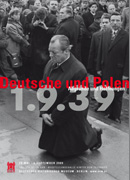


Exhibition | Oppression and Self-assertion | War and Occupation | Conflicts and Rapprochements
The Federal Republic of Germany and Poland Through 1989
| "Friendship" under the Socialist Order
Memories of the War and Polish Perception of Germany
| "A Difficult Episode"
West Germany's relations with Poland were heavily burdened by experiences before 1945. For a long time, Germans downplayed their own war crimes while bristling at the memory of their flight and expulsion at the hands of the Poles.
The reconciliation of the two nations came largely at the initiative of private individuals, as people like politician Hans Koschnick and translator Karl Dedecius made contacts on the other side of the border, thus preparing the way for a broad-based rapprochement. In 1965, the churches called for reconciliation in the Memorandum of the Protestant Church and the Polish Bishops' Letter. Such initiatives popped up in both Germany and Poland, and began to find increasing resonance on the other side of the border.
The struggle of the Polish Solidarność (Solidarity) union elicited a great deal of support among the West German public and the predicament of the Polish population in general, suffering from an economic crisis as well as the imposition of martial law since December 1982, evoked a wave of solidarity in Germany, fed by growing consciousness of German war crimes in Poland.
